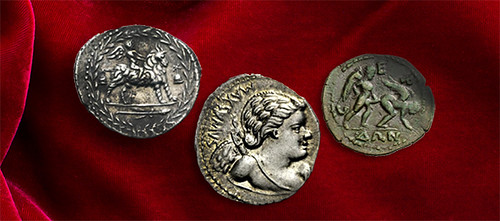
PREV ARTICLE
NEXT ARTICLE
FULL ISSUE
PREV FULL ISSUE
EROTICISM ON ANCIENT COINS
Mike Markowitz had another great article on CoinWeek recently. Here's an excerpt from his Valentine's week piece on "Eroticism on Ancient Coins". Be sure to read the entire article online (adults only)!
-Editor
It may be no surprise to the reader that classical numismatics has relatively little to tell us about the meaning of Love, a subject that has challenged both the Wise and the Foolish for millennia. In the ancient world you generally married whomever you were told to marry; a decision made by parents or clan elders based on property, political alliances and the probability of begetting healthy sons. Love had little to do with it. But ancients, like moderns, were quite interested in sex, and this sometimes found expression on coins, or coin-like objects.
Satyrs on Staters
From Eros to Cupid Eros, as the divine personification of physical love, was the son of Aphrodite. We see them together on the splendid staters (c. 400 BCE) of Nagidos in Cilicia. Aphrodite is enthroned in majesty, while the small winged figure of Eros crowns her with a wreath. On a tiny electrum 1/24th stater of Kyzikos (fifth or fourth century BCE) they stand on a tunny fish, the badge of the city.

Hero and Leander Hero was a young priestess of Aphrodite who lived in a tower in Sestos. Her boyfriend Leander lived across the strait in Abydos. Her parents forbade their love. Every night, Hero lit a lamp in the tower to guide Leander’s swim across the strait so they could be together. One dark and stormy night, the wind blew out the lamp, and Leander was swept out to sea and drowned. When his lifeless body washed up on shore the next morning, Hero threw herself from the tower and died. On rare second and third century bronzes we see a charmingly naïve rendering of the story, with Leander naked in the water and Hero atop her tower holding out her lamp. On some versions, Eros flies above the doomed lovers, bearing a torch of love.
To read the complete article, see:
The Numismatic Bibliomania Society is a non-profit organization promoting numismatic literature. See our web site at coinbooks.org. To submit items for publication in The E-Sylum, write to the Editor at this address: whomren@gmail.com To subscribe go to: https://my.binhost.com/lists/listinfo/esylum All Rights Reserved. NBS Home Page Contact the NBS webmaster 
|

